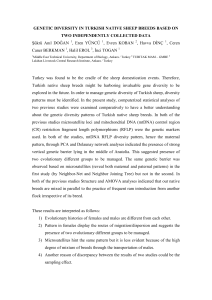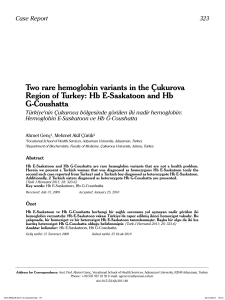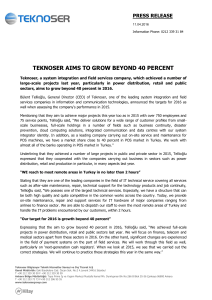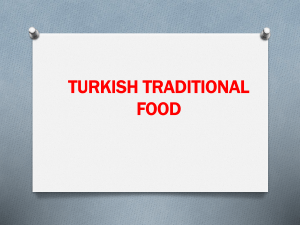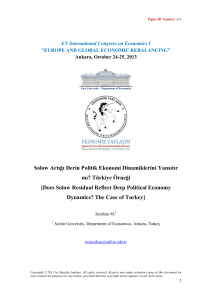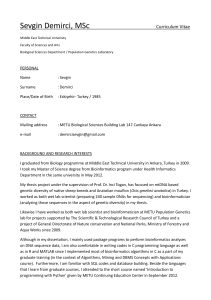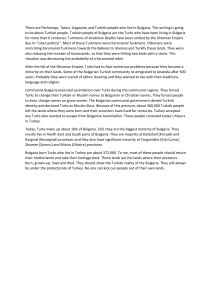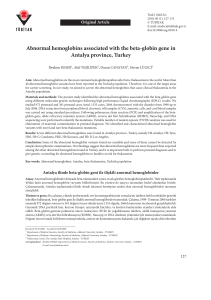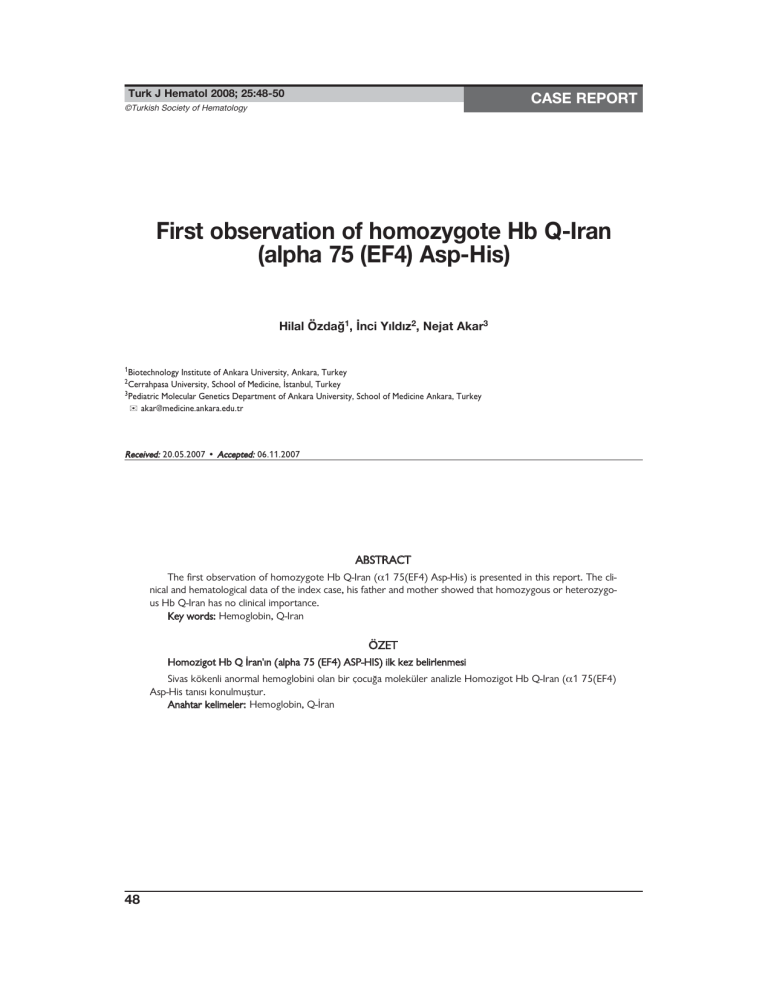
Turk J Hematol 2008; 25:48-50
CASE REPORT
©Turkish Society of Hematology
First observation of homozygote Hb Q-Iran
(alpha 75 (EF4) Asp-His)
Hilal Özda¤1, ‹nci Y›ld›z2, Nejat Akar3
1Biotechnology
Institute of Ankara University, Ankara, Turkey
University, School of Medicine, ‹stanbul, Turkey
3Pediatric Molecular Genetics Department of Ankara University, School of Medicine Ankara, Turkey
) [email protected]
2Cerrahpasa
Received: 20.05.2007 • Accepted: 06.11.2007
ABSTRACT
The first observation of homozygote Hb Q-Iran (α1 75(EF4) Asp-His) is presented in this report. The clinical and hematological data of the index case, his father and mother showed that homozygous or heterozygous Hb Q-Iran has no clinical importance.
Key words: Hemoglobin, Q-Iran
ÖZET
Homozigot Hb Q ‹ran'›n (alpha 75 (EF4) ASP-HIS) ilk kez belirlenmesi
Sivas kökenli anormal hemoglobini olan bir çocu¤a moleküler analizle Homozigot Hb Q-Iran (α1 75(EF4)
Asp-His tan›s› konulmufltur.
Anahtar kelimeler: Hemoglobin, Q-‹ran
48
First observation of homozygote Hb Q-Iran (alpha 75 (EF4) Asp-His)
INTRODUCTION
During screening surveys for beta thalassemia
and abnormal hemoglobins in ‹stanbul, a wellknown city in Turkey, a hemoglobin variant was
detected in a six–year- old boy from Sivas, a city in
Mid-Anatolia, with a hemoglobin variant mobility
similar to Hb S with a negative sickling test, with
iron deficiency anemia. Further analysis of the variant revealed it as Hemoglobin Q-Iran (a1 75
(EF4) Asp to His).
Hemoglobin (Hb) Q-Iran is a rare hemoglobin
variant, which was reported first in an Iranian, and
then in Turkish, Chinese and Pakistani families [16]. However, our case is the first homozygous Hb
Q-Iran.
CASE REPORT AND METHODS
The index case had a hemoglobin variant mobility similar to Hb S with a negative sickling test.
Routine hematological methods were used. Cellulose acetate electrophoresis analysis revealed that
the variant constituted 42.0% of the total Hb, and
Hb F (<1%) values were within normal levels. His
hematological results following oral iron therapy
for three months are shown in Table 1. Family
screening revealed the father and the mother as heterozygote carriers of the variant. Both had the variant as 20 and 22.2%, respectively. The propositus
was in homozygous state. No hematological data
was available for the parents.
Molecular techniques described previously for
the common mutations did not reveal the variant
[7]. For further variant analysis, DNA was obtained from all individuals following a written informed consent. Sequencing of the exon 1, 2 and 3 of
the beta globin gene was performed according to
our previous report, which did not reveal an abnormal variant (Beckmann Coulter, USA) [8]. The entire coding and intronic sequence of alpha-1 and
alpha-2 globin genes was amplified as one amplicon each. While the forward primer was the same
for the two genes, the reverse primers were specific to alpha-1 and alpha-2 genes. These amplicons
were sequenced using internal primers. The reactions were done using Beckman DTCS kit and run
on Beckman CEQ 8000 automated DNA sequen-
Table 1. Hematological and hemoglobin composition data of the propositus
Hb
g/dl
13.2
RBC
1012/1
5.03
PCV
L/l
39.9
RET
%
0.1
MCV
fl
72.2
MCH
pg
23.8
MCHC
g/dl
33
Hb A2
%
0.5
RDW
%
12.2
ce analysis system. The mutation located on codon
75 of alpha-1 globin gene was not present on the
alpha-2 gene amplicon. Sequence analysis was repeated on an independent polymerase chain reaction (PCR) to confirm the presence of the mutation.
Our analysis revealed an alteration of Asp to His at
75 (EF4) in homozygous state, which was named
previously as Hb Q-Iran (Figure 1).
Figure 1. Sequencing data of Hb Q-Iran.
Turk Journal of Hematology
DISCUSSION
Two individuals from two Turkish cities, Adana and Ankara, were previously reported to have
Hb Q-Iran. The latter was a 13-year-old girl with
acute lymphoblastic leukemia with a combination
of hemoglobin S and hemoglobin Q-Iran [4]. All
the reported hemoglobin Q-Iran individuals were
in heterozygote state. Here we describe a homozygous individual for hemoglobin Q-Iran without
any clinical symptoms following iron treatment.
49
Özda¤ H, Y›ld›z ‹, Akar N.
Turkey is situated at the meeting point of three continents of the world and stands as a crossroad
between Asia and Europe. Due to its geographical
location, Anatolia (Turkey) has historically been
home to the various races and ethnic groups of
three continents, a result of which is the reported
presence of many kinds of hemoglobin variants in
Turkey. Although the most important variant in the
Turkish population is Hb S, there are also several
examples of some rare variants [6,9].
Further observation of hemoglobin Q-Iran suggests that this variant is found sporadically in the
Turkish population. With description of variants
such as Hb Hamadan, Hb J Iran, Hb D Iran, Hb D
Punjab and Hb Q Iran in the Turkish and Iranian
populations, it is logical that the ancestral individuals probably immigrated from a region of Iran or
back to Middle Asia [5-14].
REFERENCES
1.
2.
3.
4.
50
Lorkin PA, Charlesworth D, Lehmann H, Rahbar S,
Tuchinda S, Eng LI. Two haemoglobins Q, alpha74 (EF3) and alpha-75 (EF4) aspartic acid to histidine. Br J Haematol 1970;19:117-25.
Lie-Injo LE, Dozy AM, Kan YW, Lopes M, Todd
D. The alpha-globin gene adjacent to the gene for
HbQ-alpha 74 Asp replaced by His is deleted, but
not that adjacent to the gene for HbG-alpha 30 Glu
replaced by Gln; three-fourths of the alpha-globin
genes are deleted in HbQ-alpha-thalassemia. Blood.
1979;54:1407-16.
Aksoy M, Gurgey A, Altay C, Kilinc Y, Carstairs
KC, Kutlar A, Chen SS, Webber BB, Wilson JB,
Huisman TH. Some notes about Hb Q-India and Hb
Q-Iran. Hemoglobin. 1986;10:215-9.
Gurgey A, Ozsoylu S, Hicsonmez G, Irken G, Altay
C. Acute lymphoblastic leukemia in a child with hemoglobins S and Q-Iran. Turk J Pediatr
1990;32:39-41.
5.
6.
7.
8.
9.
10
11.
12.
13.
14.
Abraham R, Thomas M, Britt R, Fisher C, Old J. Hb
Q-India: an uncommon variant diagnosed in three
Punjabi patients with diabetes is identified by a novel DNA analysis test. J Clin Path 2003;56:296-9.
Altay Ç, Abnormal hemoglobins in Turkey. Turk J
Hematol 2002;19:63-74.
Akar N, Akar E, Tastan H. Feasibility of restriction
enzyme protocols for the molecular diagnosis of abnormal hemoglobins in Turkish population. Am J
Hematol 1999;62:198.
Akar E, Ozdemir S, Hakki Timur I, Akar N. First
observation of homozygous hemoglobin Hamadan
(B 56 (D7) GLY-ARG) and beta thalassemia (-29
G>A)- hemoglobin Hamadan combination in a
Turkish family. Am J Hematol 2003;74(4):280-2.
Arcasoy A. Hemoglobinopathies in Turkey. Hematology Reviews 1992;6:1-7.
Arcasoy A, Turhano¤lu S, Gözdaflo¤lu S, O¤ur G.
First observation of Hb J Iran B77 (EF1) His-Asp in
Turkey. Hemoglobin 1986;10:209-13.
Bircan ‹, Güven AG, Ye¤in O, Plaseska D, Wilson
JB, Ramachandran M, Huisman TH. Hb N Baltimore [alpha 2 beta 2 (95) (FG2) Lys-Glu] and Hb J
Iran [alpha 2 beta 2 (77) (Ef1) His-Asp] observed in
a Turkish family from Antalya. Hemoglobin
1990;14:453-7.
Yenice S, Kemahl› S, Bilenoglu O, Gül Ö, Akar E, Basak AN, Akar N. Two rare hemoglobin variants in the
Turkish
population
(Hb
G-Coushatta
(B22(B4)Glu_Ala)
and
Hb
J-Iran
(B77(EF1)His_Asp). Turk J Hematol 2000;171:27-8.
Dinçol G, Aksoy M, Dinçol K, Kutlar A, Wilson JB,
Huisman TH. Hemoglobin Hamadan or alpha 2 beta 256 (D7) Gly-Arg in a Turkish family. Hemoglobin 1984;8:423-5.
Irken G, Oren H, Undar B, Duman M, Gulen H, Ucar
C, Sanli N. Analysis of thalassemia syndromes and
abnormal hemoglobins in patients from the Aegean
region of Turkey. Turk J Pediatr 2002;44:21-4.
Volume 25 • 1 • March 2008

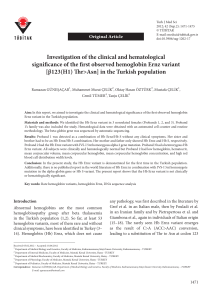
![First observation of Hb D-Ouled Rabah [beta19(B1)Asn>Lys] in the](http://s1.studylibtr.com/store/data/003346881_1-fc6465a17750760535fb52bbef4ddf81-300x300.png)
